Ten Things I Have Learned From My Backyard Sand Dune
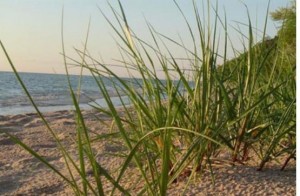 1. Beachgrass is the most important plant on a sand dune. It spreads quickly by its rhizome root system that grows down and sideways creating an underground weblike structure that holds the sand and helps to build and stabilize the dunes. Wind blown sand is trapped and held by both the root system (rhizomes and rootlets) and the exposed stalks. The dune plants may only grow a foot or so above the surface but they have roots that reach deep for water. Beachgrass acts tough: it is amazingly tolerant of high salinity conditions, direct sun, extreme heat, lack of fertile soil and a fluctuating water supply, but that tough act belies a tender structure. As part of its resistance to salinity and drying conditions it has developed a thick brittle stalk. Although Beachgrass looks tough, it’s thick brittle stalks can be easily broken and killed by walking or driving over or near the plant.
1. Beachgrass is the most important plant on a sand dune. It spreads quickly by its rhizome root system that grows down and sideways creating an underground weblike structure that holds the sand and helps to build and stabilize the dunes. Wind blown sand is trapped and held by both the root system (rhizomes and rootlets) and the exposed stalks. The dune plants may only grow a foot or so above the surface but they have roots that reach deep for water. Beachgrass acts tough: it is amazingly tolerant of high salinity conditions, direct sun, extreme heat, lack of fertile soil and a fluctuating water supply, but that tough act belies a tender structure. As part of its resistance to salinity and drying conditions it has developed a thick brittle stalk. Although Beachgrass looks tough, it’s thick brittle stalks can be easily broken and killed by walking or driving over or near the plant.
Plant lots of it and because it is a short lived plant, install more every year.
How to plant Beachgrass:
- Beach grass is sold in bundles of 50 or 100 culms (stems)
- Plant two stems per hole. Placing more than two stems per hole wil
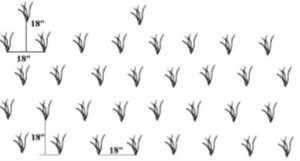 l increase competition for nutrients causing loss of plants
l increase competition for nutrients causing loss of plants - Plants should be spaced 18″ apart.
- There should be 18″ between rows.
- The rows should be staggered to provide maximum wind erosion control. (See illustration.)
- Take a broom pole or a shovel and plunge it into the sand to a depth of approx 12”
- Shove the pieces of beach grass into the hole
- Tamp it down with your heel.
- It is best to have at least two people working together – you build up a cadence as you go
- Best time to plant – October 15 to April 15
2. We need to care about dunes. First, they protect inland properties from the ravages of flood waters. My garden backs up to a state park where there are acres and acres of dunes but just around the corner, the bayfront beach dunes are being ravaged by erosion as the natural movement of sand from up bay beaches is impeded by a manmade structure; only trucked and pumped in additions of sand each year keep the water at bay (no pun intended).
Second, dunes are very important seaside habitats and are home to many plants and animals. Once stabilized by Beachgrass, the dunes can be home to a number of plant species including: beach pea, bayberry, seaside goldenrod, wild rose and cranberry. If the Beachgrass doesn’t grow or take hold, nothing will grow and the erosion process begins.
Insects such as leafhoppers scurry around the roots and leaves and feed on the plants. Resident and migratory birds such as the Savannah sparrow feed on the insects and on the small seeds and berries available from the native dune plant species. The back side of the dune attracts small and large mammals including deer, red fox and the meadow jumping mouse. These in turn attract northern harriers who hunt for food from overhead. I shudder to mention that a stable dune is also host to snakes which may be good for the ecosystem but give me pause. On the flip side the dune is also host to toads – its fun to see them hopping about.
3. Seaside Goldenrod and Beach Pea colonize alongside Beachgrass and work with it to create a stable dune. The seeds from both of these plants will sprout at the base of a Beachgrass stalk and Seaside Goldenrod will readily accept being replanted directly into a dune. Both of these plants will colonize disturbed sand on a dune and help to create an under and above sand fibrous network that holds the sand. Beach Pea though can be a thug, climbing over everything, everywhere and seeding itself with aplomb.
4. Don’t disturb the dune. Once planted, don’t bother the dune – no digging, no pets, no nothing – just enjoy looking at it and wait. It appears that the structure of the sand is important to the growth of what I call the second stage plants; those that will only come after the Beachgrass has created a stable situation. These include Pine, Bayberry and Beach Plum. So far I have no scientific basis for this thought – just observation.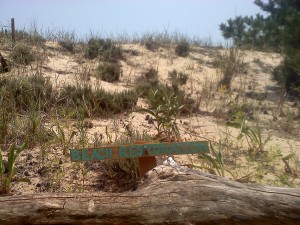
5. Dune plants seem to be dead and then one day – or one year they wake up and grow like crazy. I attribute this to root establishment. Whether it is Beachgrass or Seaside Goldenrod or Beach Plum, when planted they just seem to sit there doing nothing until their roots are established. This can take a few days in the case of Seaside Goldenrod or a year or two in the case of Beach Plum. You don’t notice this with plants that seed in as much probably because they grow roots first and then concentrate on foliage…just a guess.
6. Dune plants like to play dead even when they are established. This behavior varies with drought cycles – much like a desert that springs to life after a rain, dune plantings will often go into a suspended state and look dead in the heat of the summer droughts and then spring to life again once the rains come.
7. Dune landscapes offer many microclimates for planting and punish bad plant location. The front face of the dune – ocean side – is a harsh environment because it bears the brunt of sea spray, wind driven sand, sun, occasional seawater inundation and just plain old wind. Beachgrass seems to thrive there.
The back face of the dune is sheltered but still harsh. The sand shifts and moves with the wind but the salt spray and the wind pressure are moderated offering the opportunity to use Beachgrass as a stabilizer and then establish Beach Heather, Goldenrod, Pine, Beach Plum and Bayberry. The woody plants established in sand may grow as foreshortened versions of their cousins located just feet away in the bottom area between or behind the dune.
The bottom or behind area often thrives with plants because it is more nutrient rich as the detritous from the dune plantings is driven there, more moisture rich because that area acts as a drainage basin and because many seeds are deposited there by wind and water.
Why is this important? The success of installing any plant on a dune is not determined by planting zone, the amount of watering or the fact that the plant is native. It is determined by inches – the inches between dune planting zones so get to know your dune before you design a garden and most importantly before you dig.
8. Beach Plums and Bayberries like messy sand. I have found that if these two are grown near a black or loblolly 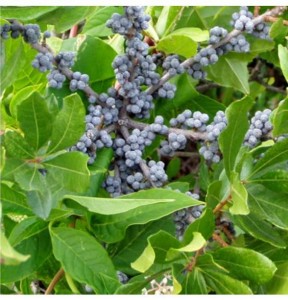 pine or are mulched with the needles from the same, they grow well but if left alone or with hardwood mulch they do not thrive or they fail altogether. I wonder if a symbiotic relationship exists between the plum/bayberry and the pines or if it is the added acidity in the soil. Note that even native cactus gets fried in the summer sun but seems to thrive with a pine needle mulch.
pine or are mulched with the needles from the same, they grow well but if left alone or with hardwood mulch they do not thrive or they fail altogether. I wonder if a symbiotic relationship exists between the plum/bayberry and the pines or if it is the added acidity in the soil. Note that even native cactus gets fried in the summer sun but seems to thrive with a pine needle mulch.
9. It takes patience to work with a sand dune. Unless you truck in loads of soil, establishing a sand dune garden takes time and patience. But insta-garden isn’t the point, dune restoration is. That takes careful planning, plant selection, lots of failure, time and then success.
10. Signage matters. We have put up all manner of fences but no one has paid any mind to them and they have continued to transit over the dune. Now all fences are gone, just a little edging and no one steps on the dune. What’s the difference? Two little hand painted signs explaining that a beach restoration is in progress – please keep off the dune. A
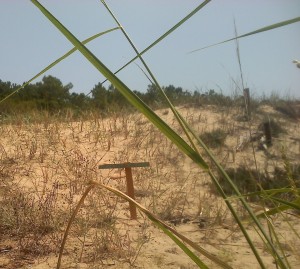 Please Keep Off Dune Sign
Please Keep Off Dune Sign
little education, a reason and poof!
We are hoping that our little sand dune restoration inspires others to plant native and help to maintain the beach ecosystem that is so valuable to the protection of our properties and our communities. Nestled into the back side of the dune we have placed a deck with a grill, lounges and planters with herbs and flowers so that we can relax and enjoy the peace of the beach and watch the beauty of the ecosystem unfold before our eyes.
SOME NATIVE PLANTS For Your Dune Garden
American Beachgrass – Ammophila breviligulata
Bayberry – Myrica pensylvanica
Beach Heather – Hudsonia tomentosa
Beach Plum – Prunus maritima
Dewey Blue Panicgrass – Panicum amarum
Broom Sedge – Andropogon virginicus
Common Yucca
Eastern Prickly Pear Cactus – Opuntia humifusa
Eastern Red Cedar – Juniperus virginiana
 Beach Restoration Sign
Beach Restoration Sign
Groundsel bush – Baccharis halimifolia
Hyssop-leaved Thoroughwort – Eupatorium hyssopifolium
Pine – Virginia, Pitch, Loblolly
Purple Sandgrass – Triplasis purpurea
Sea Rocket – Cakile harperi
Seaside Goldenrod – Solidago sempervirens
Wax Mrytle – Morella cerifera
{ 4 comments… read them below or add one }
Amy,
I have a summer house out on Long Beach Island and this spring the local township is giving out small bar root bayberry and beach plum plants for planting in and around the dunes. Each fall we plant dune grass but have always wanted bayberry and beach plum.
What would you suggest is the best way to plant them.
I was thinking of mixing a couple handfulls of peat moss into the sandy soil at time of planting. I’m an avid gardener but this is not my strength. So any help you couple provide would be appreciated. The Cornell guide seems meant more for inland farming.
Thanks,
@AmyAtGreenbeams It is exciting to get free plants and being able to get bayberry and beach plum plants that are grown near the place you want to plant them is a rare treat. Be aware that the transplant mortality rate for both species is high. That said, I would not use peat moss. I would get organic compost or leaf mold and mix that with the sand. That will enrich the ‘soil’ and then I would heavily mulch the plants with pine detritus from under a locally grown loblolly or other native pine. My theory is that there are beneficial organisms in that detritus that make the plants feel like they are companion planted with a pine, Good luck and let me know how they do.
Amy
Is yours really a back yard garden or is it one that permits visitors? Norfolk Master Gardeners maintain a Native Dune Demonstration Garden on the Chesapeake Bay (VA) on the secondary side of the bay and are avid about sustaining the Dune!
It is a back yard garden but that does not stop people from dropping by!